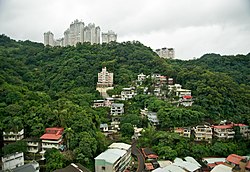|
Xindian District
Xindian District (Chinese: 新店區; pinyin: Xīndiàn Qū) is an inner city district in the southern part of New Taipei City, Taiwan. NameXindian's name originated during the Qing Dynasty close to 300 years ago. According to legend, a person named Lin and others came from Quanzhou, Fujian Province. On a mountain road leading to Wulai, they built a small cabin and opened a store selling groceries for the exchange of goods with mountain aborigines. Since the store had no formal name, travelers called it Sintiam (Chinese: 新店; pinyin: Xīndiàn; Pe̍h-ōe-jī: Sin-tiàm; lit. 'new store'). An area usually not considered as part of Xindian is Ankeng (安坑), although it is within the jurisdiction of the district, located in a valley on the west side of the Xindian Creek. It was originally called Amkhe'ar (暗坑仔; Ànkēngzǎi; Àm-kheⁿ-á; 'dark/secret gorge'), due to luxurious vegetation in the area. However, it was later decided to be indecent and the name was changed to Ankeng (安坑; Ānkēng; An-kheⁿ; 'peaceful gorge'). HistoryEmpire of JapanIn 1920, during the period of Japanese rule, the area was established as Shinten Town (Japanese: 新店街), Bunsan District, Taihoku Prefecture. Republic of ChinaThe Kuomintang government moved the seat of government (in exile) of Fujian Province to Xindian from 1956 to 1996.[citation needed] Although in 1980, it was still underdeveloped, the four-lane Zhongxing Road helped to develop the city, While areas south of Xiaobitan were still farmland. After Freeway 3 opened, parks along Xiaobitan and Xindian Creek gave way to development. With the opening of the Taipei Metro, more commercial development and businesses have come into the area. In 2004 when the Tzu Chi Hospital branch opened, replacing a water park, a new road was constructed to deal with traffic. Originally established as urban township of Taipei County, Xindian was upgraded to a county-administered city on 15 January 1980. After Taipei County was upgraded to New Taipei City on 25 December 2010, Xindian City became a district. Geography  Xindian is located on the south side of the Taipei Basin, mainly on the plains between the Xindian Creek, its tributaries, and the mountains (the Xueshan Range). The Nanshi River merges with the Beishi River in Xindian, forming the Xindian Creek, one of the major tributaries of the Tamsui River. The Xindian Creek generally flows from south to north, dividing the city into east and west sides of the creek. Although the western side (Ankeng) covers a larger area, residential, administrative, commercial, and transportation centers are all on the eastern side of the creek at Dapinglin (大坪林). Most of the population in the Ankeng region is mainly concentrated in the southeastern hillside residential communities. The district is located in southern New Taipei City. To the north is the Wenshan District of Taipei City and the Jingmei River, to the east it borders the district of Shiding, to the south it borders the district of Wulai, and to the west it borders the district of Sanxia.[1] Compared to other districts in New Taipei City, Xindian is more influenced by Taipei City; the Taipei Metro extends into Xindian, via the Xindian Line and Xiaobitan Branch Line. Five Metro stations are located in Xindian: Xiaobitan; Dapinglin; Qizhang; Xindian District Office; and the main Xindian Metro station. Feitsui Dam is also located in the district. Xindian has many traditional markets that have decades of history. The New Taipei City Police Department has ten divisions in Xindian.[citation needed] Administrative divisionsXindian is divided into 69 villages (里), then further divided in 1,447 neighborhoods (鄰). Government agencies
EducationUniversitiesVocational schools
High schools
Junior high schools
Elementary school
Tourist attractions
Transportation Taipei Metro
Ankeng light rail
National Highway No. 3 can also be reached via the district. Sister cities
Notable natives
Galleries
See alsoReferences
External linksWikimedia Commons has media related to Xindian District, New Taipei. Wikivoyage has a travel guide for Xindian.
|
||||||||||||||||||||||||||||||||||||||||||||||||||||||||||




